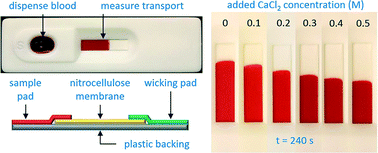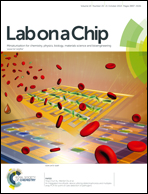Blood coagulation screening using a paper-based microfluidic lateral flow device†
Abstract
A simple approach to the evaluation of blood coagulation using a microfluidic paper-based lateral flow assay (LFA) device for point-of-care (POC) and self-monitoring screening is reported. The device utilizes whole blood, without the need for prior separation of plasma from red blood cells (RBC). Experiments were performed using animal (rabbit) blood treated with trisodium citrate to prevent coagulation. CaCl2 solutions of varying concentrations are added to citrated blood, producing Ca2+ ions to re-establish the coagulation cascade and mimic different blood coagulation abilities in vitro. Blood samples are dispensed into a paper-based LFA device consisting of sample pad, analytical membrane and wicking pad. The porous nature of the cellulose membrane separates the aqueous plasma component from the large blood cells. Since the viscosity of blood changes with its coagulation ability, the distance RBCs travel in the membrane in a given time can be related to the blood clotting time. The distance of the RBC front is found to decrease linearly with increasing CaCl2 concentration, with a travel rate decreasing from 3.25 mm min−1 for no added CaCl2 to 2.2 mm min−1 for 500 mM solution. Compared to conventional plasma clotting analyzers, the LFA device is much simpler and it provides a significantly larger linear range of measurement. Using the red colour of RBCs as a visible marker, this approach can be utilized to produce a simple and clear indicator of whether the blood condition is within the appropriate range for the patient's condition.


 Please wait while we load your content...
Please wait while we load your content...